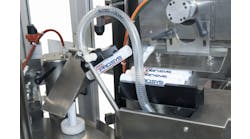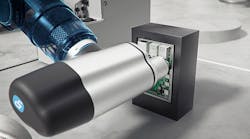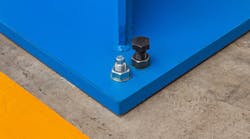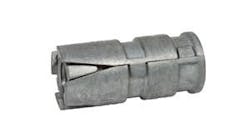Fastening door frames is not a simple “open and close” type of application. Special consideration must be given when door frames are fastened because there is a wide range of base materials that will be present for this application. Base material located around door frames could be concrete, brick or block, and may range from solid wood to hollow steel.
Often, there is a limited choice of effective concrete anchors that can be used in order to accommodate the unique properties of door frames and/or special requirements present in a location.
Hollow Metal Door Frames
- Standard measurement of 1-3/4 inch thick
- Manufactured from 16, 18, and 20-gauge steel
- Made using Galvannealed steel through a process in which an extra tight coat of metal zinc is applied to a soft steel sheet and then passed through an oven at about 1,200°F to create a dull gray coating suited for painting
Wood Frames
- Wood door frames come in many different thicknesses and wood types
- The exact specifications of the particular door frame being mounted will determine the length of the concrete fastener needed
- It is important to remember that a flat countersunk head anchor must be used and sit flush with the outside surface of the door frame
Concrete Fasteners That Can Be Used in Concrete, Brick or Block
Once the style and type of door that has been chosen, then the base material of the opening in which the door will be placed must be determined. The base material will determine the type of fasteners useful in a particular application. Most concrete fasteners are not available in a flat head countersunk head, which creates a smaller selection for the correct anchor.The sleeve anchor and Tapcon concrete screw are manufactured with a flat head Phillips countersunk head and are readily available. A female type anchor with a flat countersunk head can be used but is not recommended because it can be difficult to apply in this setting.
Both the sleeve anchor and Tapcon allow door frames to be placed in position, leveled, and plumbed before the anchor is inserted through the door frame. There is no prior spotting of the hole. Simply drill the hole in the base material with the door frame in place, then insert the concrete anchor and tighten.
Sleeve Anchors for Attaching Door Frames
- Sleeve anchors are versatile concrete fasteners because they come in a wide range of lengths, head styles, and diameters
- Sleeve anchors are designed to be used in a variety of base materials including concrete, brick, and block
- These anchors are available in four head styles: acorn, hex, round, and flat head. A flat head sleeve anchor would work perfectly for fastening metal door frames to base materials
- Sleeve anchors are manufactured for the hole size and the countersunk head type is designed into the door frame
- The length of the anchor to be used will be determined by the thickness of the metal door frame plus the minimum embedment for a 3/8-inch sleeve anchor- which is 1-1/2 inches.
The first table below displays the holding values in concrete; the second table describes the holding values in grout-filled blocks:
** Note that the holding values are based on 1-1/2 inch embedment into the concrete and are ultimate loads. To calculate a safe working load, divide the ultimate load by 4.
Tapcon Concrete Screws for Attaching Door Frames
- The only diameter of Tapcon that comes in a 4, 5 or 6-inch lengths is the 1/4-inch diameter concrete screw, which is a smaller diameter than the sleeve anchor but is used by many door installers for this application
- The flat countersunk head is large and fits nicely into the hole with a countersink manufactured into the metal door frame
- Tapcons are perfect for wood frame doors because they are easy to use and make their own countersink in the wood as the screw is torqued into the base material
- Note that these concrete screws are threaded for a length of 1-3/4 inches from the point of the screw because they require a depth of embedment into the base material of no more than 1-3/4 in. and a minimum embedment of 1 inch.
















